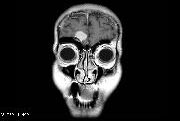Learning Objectives
- Arterial dissection may occur after trauma or spontaneously
- The diagnosis of this disorder requires a vascular imaging study, such as CTA or MRA
- Treatment of dissection may be mild anticoagulation
History
A 17 year old hockey player was accidentally hit on the left side of the neck with the puck, producing immediate pain. Minutes later, she felt a throbbing pain radiating from the left side of the neck to the eye. She felt she had trouble focusing from the left eye and she stopped playing. She denied numbness or weakness. After the game she went home. The headache continued and it did not improve with ibuprofen or acetaminophen. Her parents brought her to the local emergency room, where it was found that the left pupil was smaller than the right and the left eyelid seemed a little droopy.
Examination
Her blood pressure is 131/82 and pulse 82. She is a healthy, alert young lady. The left pupil is smaller than the right. She has mild left-sided ptosis. There is a slight bruit over the left carotid artery and a superficial skin contusion on the left side of the neck. Movements of the eyes are normal. Facial sensation is normal on both sides. Facial expression is normal. Hearing is normal. Movement of the shoulders and the tongue are normal. The remainder of the neurological exam is normal.
Neuroanatomy and Localization
The patient has a left-sided partial Horner’s syndrome, including ptosis and miosis (decreased pupil size relative to normal). The pupil change may be caused by decreased input of the sympathetic nerve supply to the left pupil via the oculomotor nerve. The location of the lesion could be within the oculomotor nerve, the carotid artery, descending sympathetic ganglia adjacent to the cervical spine, within the spinal cord or within the brain stem. Ascending sympathetic nerve fibers surround the carotid artery in the shape of a plexus. Considering the history of neck trauma, the carotid artery is the likely location.
Diagnosis
As you read in other sections, sometimes changes in the arteries result in pain. In this case, a trauma of apparent benign significance resulted in pain and altered vision. It is a good idea to consider a condition called arterial dissection. The arteries carry blood from the heart to our body. They have a muscular wall which helps them respond to changes in the blood pressure and to direct the blood to places where it is needed. There are three layers of the wall, which are referred to as the intima (inner lining), media and the adventitia. Sometimes an injury, as in this case, results in a tearing of components of the wall. When the inner lining of the arterial wall is torn, the flowing blood may flood into the tear, causing the inner layer to dissect away from the other layers. This may cause the artery to stretch, bulge, or the inner lumen to narrow, resulting in decreased blood flow, a painful stretching of the artery, or in this case, injury to the nerves that control pupil dilation and the opening of the eye.
Sometimes people may have a special condition that predisposes them to arterial dissection. This may happen even in the absence of an injury. If certain arteries are affected, there may be no pain. One condition related to arterial dissection is fibromuscular dysplasia. This tends to affect the renal and carotid arteries and tends to be found in women between 30 and 50 years old. Sometimes cases of vasculitis or atherosclerosis can be related to dissection.
The diagnosis of an arterial dissection is normally made with a study of the arterial anatomy. This may be an ultrasound, an MRA (which is an MRI that looks at the arteries) or an angiogram, either done by CT or by other means.
Treatment
When someone has an arterial dissection, we often treat them with medicine that prevents blood clots (anticoagulation). These medicines may consist of aspirin, warfarin, heparin, or others. Pain control may also be needed. There are no special pain medicines for this condition- many types of pain relievers may be useful.
Although we consider an arterial dissection to be a medical emergency, most cases result in complete resolution. This is a rare condition, which is not routinely considered to be a cause of headache pain. It is more often worth consideration for new, sudden onset abnormal neurological findings, and especially in cases of injury.
Review Questions
- The mechanism or warning symptom of an arterial dissection is
a. stroke
b. trauma
c. headache
d. visual symptoms
e. dissection often occurs spontaneously - Arterial dissection requires which of these tests for a diagnosis
a. auscultation of a bruit
b. MRI of the brain
c. CT of the head
d. vascular imaging, such as CTA, MRA, or angiogram
e. All of the above - Treatment of an arterial dissection
a. may require pain control medication
b. may be done with aspirin
c. may be done with warfarin
d. may be done with heparin
